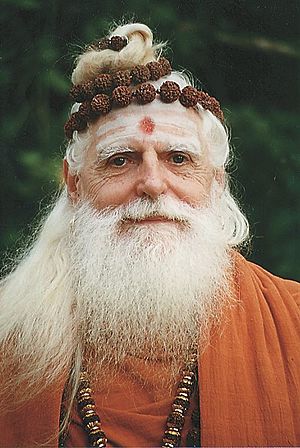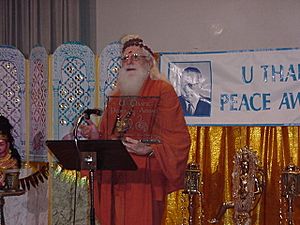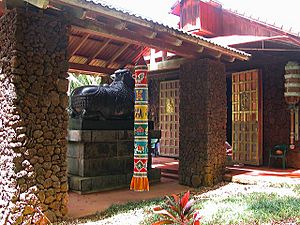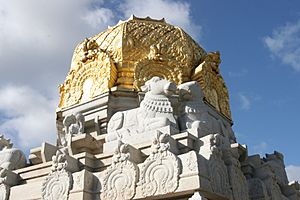Sivaya Subramuniyaswami facts for kids
Quick facts for kids
Sivaya Subramuniyaswami
|
|
|---|---|

Sivaya Subramuniyaswami
|
|
| Born |
Robert Hansen
5 January 1927 |
| Died | 12 November 2001 (aged 74) |
Sivaya Subramuniyaswami, born Robert Hansen, was an American Hindu leader. His followers called him Gurudeva. He was born on January 5, 1927, and passed away on November 12, 2001.
He was born in Oakland, California. As a young man, he chose to follow Hinduism. He became the 162nd head of the Nandinatha Sampradaya's Kailasa Parampara. He was also the Guru at Kauai's Hindu Monastery. This is a large temple and monastery complex in Hawaii.
In 1947, when he was 20, he traveled to India and Sri Lanka. In 1949, he became a sannyasa (a monk). He was initiated by Jnanaguru Yogaswami of Jaffna, Sri Lanka. Yogaswami was a famous yogi and worshiper of Lord Shiva. He was seen as one of the most important mystics of the 20th century.
In the 1970s, Sivaya Subramuniyaswami started a Hindu monastery in Kauai, Hawaii. He also created the magazine Hinduism Today. In 1985, he started the festival of Pancha Ganapati. This was a Hindu celebration for December, like Christmas. He was a Guru of Shaivism, and he founded the Saiva Siddhanta Church.
He was part of the guru lineage from Alaveddy, Sri Lanka. His organizations grew from his Sri Subramuniya Ashram in Alaveddy. They helped Hindus living around the world. He also built a monastery in Mauritius. It has a public Spiritual Park called "Spiritual Park- Pointe de Lascars." He guided more than 50 independent temples worldwide.
His many books spread his ideas far and wide. He wrote about 30 books. Klaus Klostermaier called him "the single-most advocate of Hinduism outside India." The book Religious Leaders of America said he was "a pillar of orthodox Hinduism."
Contents
Biography
Early Life in California (1927–1946)
Sivaya Subramuniyaswami was born Robert Hansen in California in 1927. He said that from age six, he felt a strong sense of "the power of the eternity of the moment." He was greatly inspired by Swami Vivekananda's life and his four books: Raja Yoga, Bhakti Yoga, Karma Yoga, and Inspired Talks. He especially loved Swami Vivekananda's poem, "The Song of the Sannyasin."
Sivaya Subramuniyaswami learned classical Eastern and Western dance. He also practiced yoga. This training helped him become a skilled dancer. He joined the San Francisco Ballet Company. By age nineteen, he was a danseur (male ballet dancer). When he was twenty, he took the first ship to India after World War II. He turned twenty-one just before arriving in Mumbai. He walked through the grand Gateway to India there.
Time in Sri Lanka (1947–1949)
Sivaya Subramuniyaswami spent almost three years in Ceylon, which is now called Sri Lanka. Before meeting his main guru, he studied with another teacher for about a year and a half. Sivaya Subramuniyaswami wanted to meditate. But his teacher made him help villagers rebuild their homes. He visited and lived in many Buddhist temples in Sri Lanka. He learned about the monks' lives and their customs. This experience greatly shaped the strict rules he later set for his own monastic order.
In the caves of Jalani, Sri Lanka, he fasted and meditated. He felt he reached enlightenment there. He described his feelings returning to Colombo, Sri Lanka: "Everything looked different. I was in another dimension. I felt complete. I felt alone."

Back in Colombo, Sivaya Subramuniyaswami met another teacher. One day, this teacher arranged a meeting between Sivaya Subramuniyaswami and his long-awaited satguru, Sage Yogaswami. After a deep meeting, Yogaswami gave him the name Subramuniya. This name is an epithet of Sri Murugan. Subra means "the light from the central source." Muni means a silent teacher. Ya means restraint. So, Subramuniya means a self-controlled soul who is silent or speaks from intuition.
After a few visits, Jnanaguru Yogaswami made Subramuniya a sannyasa. He welcomed him into his spiritual family with a slap on the back. He told him: "This sound will be heard in America! Now go ‘round the world and roar like a lion. You will build palaces (temples) and feed thousands." Several people from Jaffna saw this event.
Yogaswami kept in touch with Sivaya Subramuniyaswami through Kandiah Chettiar until 1964. Subramuniya was seen as the 162nd Jagadacharya (world teacher) of the Nandinatha Sampradaya's Kailasa Parampara.
San Francisco (1949–1970)
In late 1949, Subramuniya sailed back to America. He spent seven years practicing yoga and meditation alone. In 1956, Sivaya Subramuniyaswami said he had a huge spiritual experience in Denver, Colorado. He felt his "soul body would finally fully inhabit the physical body." The next year, in San Francisco, Subramuniya founded what is now Himalayan Academy. He opened America's first Hindu temple there. In Switzerland, in 1968, he wrote about Shum. This is a special language of meditation that describes inner areas of consciousness.
Kauai (1970–2001)
Sivaya Subramuniyaswami moved his ashram to Kauai in 1970. He started Kauai Aadheenam there. It is on a riverbank near an old volcano. This place is also known as Kauai's Hindu Monastery. It is a large temple and monastery complex on Hawaii's Garden Island. In 1979, he published the Holy Orders of Sannyas. This book described the ideals and vows of Hindu monasticism.
In 1979, he also started the Hinduism Today magazine. In the early 1980s, after traveling the world, he focused the magazine on uniting all Hindus. He wanted to inspire and educate people everywhere. In Sri Lanka, Sivaya Subramuniyaswami officially took over the main building of his Sri Subramuniya Ashram in Alaveddy, which he founded in 1949.
In 1986, Sivaya Subramuniyaswami started a branch monastery in Mauritius. The government asked him to come there to help "revive a languishing Hindu faith." In 1991, he wrote the Nandinatha Sutras. These are 365 short sayings that explain how to live a good Hindu life. In the early 1990s, he worked to ensure temple priests were treated fairly. He believed they should get the same respect as clergy of other religions.
In 2000, he published How to Become a Hindu. This book showed people how to formally join the faith. It challenged the idea that "You must be born a Hindu to be a Hindu." In November of that year, he launched Hindu Press International (HPI). This was a free daily news summary sent by email and posted online. In 2001, he finished his 3,000-page Master Course trilogy. It included Dancing with Siva, Living with Siva, and Merging with Siva. These books offered daily lessons on Hindu philosophy, culture, and yoga.
Death
On October 9, 2001, he learned he had advanced intestinal cancer. Doctors confirmed that treatments would not work. He chose not to have treatment. Instead, he decided to follow an Indian yogic practice called prayopavesha. This means to stop eating and only drink water. He passed away peacefully on the 32nd day of his fast. It was 11:54 pm on Monday, November 12, 2001. His twenty-three monks were with him.
Spiritual Lineage
He followed the shaivism sect of Hinduism, specifically Shaiva Siddhanta. This tradition is common in South India, Sri Lanka, and Malaysia. He belonged to the Nandinatha Sampradaya's Kailasa Parampara.
His spiritual lineage includes:
- Maharishi Nandinath
- Tirumular
- ... (many others)
- Nameless rishi from himalayas
- Kadaitswami
- Chellapaswami
- Siva Yogaswami
- Sivaya Subramuniyaswami
- Bodhinatha Veylanswami
| Religious titles | ||
|---|---|---|
| Preceded by Satguru Siva Yogaswami of Jaffna, Sri Lanka |
162nd Satguru (Spiritual Preceptor) 1959 – November 12, 2001 |
Succeeded by Satguru Bodhinatha Veylanswami |
| Guru Mahasannidhanam, Kauai Aadheenam 1970 – November 12, 2001 |
||
Honors and Awards

- 1986 - The New Delhi Parliament of the World's Religions named Sivaya Subramuniyaswami one of five modern-day Jagadacharyas. This means "world teachers." They honored him for his global efforts to promote Hinduism.
- 1988 - In Oxford, England, he represented Hinduism at the Global Forum of Spiritual and Parliamentary Leaders for Human Survival. He joined religious, political, and scientific leaders to discuss the future of human life.
- 1990 - He again represented Hinduism at the Global Forum in Moscow.
- 1992 - He represented Hinduism at the Global Forum in Rio de Janeiro.
- 1993 - In Chicago, at the 100-year anniversary Parliament of the World's Religions, Sivaya Subramuniyaswami was chosen as one of three presidents. He, Swami Chidananda Saraswati, and Mata Amritanandamayi represented Hinduism.
- 1995 - The New Delhi Parliament of the World's Religions gave Sivaya Subramuniyaswami the title Dharmachakra. This was for his amazing publications.
- 1997 - Sivaya Subramuniyaswami gave the Hindu view on the ethics of cloning when the US President asked for religious opinions.
- 1997 - He led the 125th anniversary of Satguru Yogaswami. A golden statue of Yogaswami traveled to many of the 75+ Sri Lankan temples and groups worldwide.
- 2000 - On August 25, he received the U Thant Peace Award at the United Nations in New York. Famous people like the Dalai Lama, Nelson Mandela, and Mother Teresa had received this award before. He spoke to 1,200 spiritual leaders at the UN Millennium Peace Summit. His message was: "For peace in the world, stop the war in the home."
Books Written
Gurudeva wrote over 30 books. They shared ideas about Hindu metaphysics, Saivism, mysticism, yoga, and meditation. Many modern Hindu leaders highly respect his works.
His Master Course is a huge work on Shaivism. It has three books and over 3,000 pages. He wrote it in a style he called "talkanese." This is a flowing written English that sounds like spoken language. It reminds people of ancient Hindu oral traditions.
His Master Course includes these three books:
- Dancing with Siva
- Living with Siva
- Merging with Siva
Some of his other books are:
- Yoga's Forgotten Foundation
- Loving Ganesha
- How to Become a Hindu: A Guide for Seekers and Born Hindus
- Tirukkural: The American English and Modern Tamil Translations of an Ethical Masterpiece
- Holy Orders of Sannyas: A Saiva Swami's Diksha and Lifetime Vows of Renunciation
- Weaver's Wisdom: Ancient Precepts for a Perfect Life
- Pancha Ganapati: An alternative for Christmas
Four Areas of Service
Sivaya Subramuniyaswami set up four main areas of service. His successor, Satguru Bodhinatha Veylanswami, and the monks now continue this work. These areas are: Saiva Siddhanta Church, Himalayan Academy, Hindu Heritage Endowment, and the Hinduism Today international quarterly magazine.
Saiva Siddhanta Church
The Church's goal is to protect and promote the Śaivite Hindu religion. Members of the Church live in many countries. These include the US, Canada, Mauritius, Malaysia, Singapore, India, Sri Lanka, and several European nations.
Hindu Heritage Endowment
Hindu Heritage Endowment is a public service trust. Sivaya Subramuniyaswami founded it in 1995.
Hinduism Today Magazine
Hinduism Today is an international magazine published four times a year. Sivaya Subramuniyaswami started it in 1979. It is a public service from his monastic order. Its purpose is to make all Hindu traditions stronger. It does this by inspiring and informing Hindus everywhere.
See also
 In Spanish: Sivaya Subramuniyaswami para niños
In Spanish: Sivaya Subramuniyaswami para niños
- Tirukkural translations into English
- List of translators into English
- Hinduism in the United States



